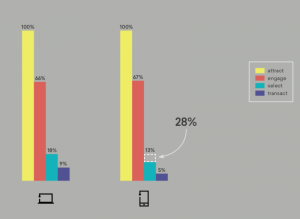Why is it Important to Grow Your List?
In ecommerce, we talk a lot about how to grow your email list. It’s possible you’ve wondered at some point: “Is my email list really that important?”
“Shouldn’t I be focusing on conversions instead of leads?”
Although generating conversions will always be your main goal, leads pave the way for conversions and ensure that users who may not buy at first can be converted later. Research has shown that the average return on investment for email marketing is approximately 4300%. In addition, emails are approximately 4-6x more likely to generate a click through than a social media post.
While on-site strategies are an important part of an optimized conversion strategy, the vast majority of users won’t convert on their first visit to your site. That’s not because your strategies are ineffective. It’s because most ecommerce shoppers browse with relatively low intent. Most people who visit your site aren’t browsing with the explicit purpose of buying.
How Can You Grow Your List and Combat Low Intent Shopping?
When a shopper signs up for your email list, it means they have interest in who you are and what you offer, even if they don’t convert. Having a shopper’s email enables you to contact them in any number of circumstances.
For instance, a great email list gives you the ability to effectively promote a new product line or send customized recommendations. You can alert shoppers of sales and discounts. You can send personalized remarketing messages. You can even foster customer loyalty and generate repeat purchases with lifecycle emails.
In short, your email list is your lifeline, the way you communicate with customers, and how they expect to hear from you.
The most successful lead capture strategies are those that leverage the interest of a shopper (even a low intent one) and parlay that into a successful lead. Let’s take a look at 8 on-site strategies that will engage your audience, fight low intent shopping, and grow your email list.
8 On-Site Strategies to Grow Your List
1. Save Their Cart for Later
As we all know, just because a user adds something to their cart does not mean that they’re committed to buying it in the current session. Many users treat the cart as a place to keep products that they’re interested in, as opposed to products they want to purchase immediately.
That means that while the user may not want to buy everything in their cart, the cart is still a helpful organizational shopping tool. That’s where a Cart Preserver can come in handy.
By offering to save a user’s cart for later, you’re effectively allowing them to save their progress. This allows them to pick up where they left off from any device – creating an omnichannel experience that allows you to continue the conversation and remarket in a way that’s helpful and organic.
2. Offer a Small Incentive
Incentivized lead captures remain popular because it’s simple and effective. Since the user is giving you something of value (their email address), giving them something of value in return helps make this exchange feel equitable.
Incentives do not need to be large to be effective. 10% Off or Free Shipping can be enough to get a user off the fence and onto your list. From there, you can leverage that incentive and remind users to redeem their offer in a remarketing series. As always, it’s wise to A/B test your incentives to determine which offers you the greatest ROI.
3. Gamify the Experience
If you’re planning to use incentivized lead capture, gamification can be a great way to increase the effectiveness of these strategies. Gamified lead capture often involves allowing users who sign up for your list to play a game of chance for an incentive. While these games are often a wheel or spinner, other games based on cards, bingo, and lottery tickets are popular too.
The incentive can be fixed to offer them the same discount every time, or it can be set to distribute certain prizes at certain rates. This allows you to offer a relatively large incentive as a potential prize without requiring you to give it out frequently – large incentives can be reserved for a few lucky players, while still offering some form of small incentive to each player.
4. Promise Future Offers + Updates
While incentives are a great way to engage an audience, it’s not always feasible to offer a unique incentive to everyone who joins your email list. However, it’s very likely that shoppers on your email list will, from time to time, receive special offers, discounts, and/or sale information that will help them save money.
If you’d rather not immediately give the visitor an incentive, another effective tool can be to offer users “exclusive offers” in the future. You can frame this as insider information that they won’t receive anywhere else.
This helps visitors get excited about joining your list without requiring you to make specific promises about what they’ll receive. It also helps people get to know your brand, and means they’ll be engaged on your list as they look for special offers.
5. Promote Your Newsletter
Offering to sign a user up for your newsletter is one of the simplest, least expensive, and most effective ways to collect a lead. Newsletters have been the bread and butter of long-form brand communications for decades. These publications are a great way to get people involved and encourage users to see everything you have to offer.
Part of the reasons that newsletters are such an effective lead capture tool is that they leverage interest rather than purchase intent. For example, a user may be interested in your site and products, but not be ready to make a purchase. While they have high interest, they have low intent.
A newsletter allows them to learn more about you without requiring them to make a purchase. After you’ve built a relationship with them, you can increase your remarketing efforts and bring them back to convert.
6. Offer Price Drop Alerts
As a strategy, Price Drop Alerts offer the best of both worlds: a convenient way to combat price sensitivity while not requiring an incentive. Price Drop Alerts initially became popular in the travel industry, but they’ve since become a widely used tool that leverages natural price fluctuations to convert users in a variety of scenarios.
Since Price Drop Alerts are highly personal, they can make a larger sale feel like a special offer created exclusively for the recipient. In addition, Price Drop Alerts are an easy way to determine the kinds of products that a customer is interested in – allowing you to improve your recommendations and further tailor your marketing strategies.
7. Send Back in Stock Notifications
An out of stock item is typically a lose-lose situation. Shoppers can’t get the item they want and you miss out on sales. Back in Stock Notifications turn an out of stock product into an opportunity, all without requiring a discount.
When an item is out of stock, simply offer to contact the user as soon as the item is back in stock. In addition to gathering their email address, you’ll be personalizing the shopping experience and building a relationship with a user, even if they’ve never purchased from you before.
8. Have Users Refer a Friend
Research shows that virtually no form of marketing is as effective as personal recommendations – 92% of consumers trust friends and family over any form of advertising. Refer-a-Friend programs allow you to combine remarketing with the power of Word of Mouth.
While this form of lead capture does generally require an incentive, it maximizes the value of the engagement by combining the discount with personal recommendations.
To start, simply offer a current customer an incentive for their next purchase if they’ll refer a friend. Generally, the referral should include the same incentive for the person being referred, usually a small discount.
After they enter their friend’s email, be sure to include the friend’s name in the email you send to the new lead. This prevents the person (who may be unfamiliar with your site) from wondering why they’re getting the message.
While refer-a-friend programs are popular and effective, they’re generally not compliant with email regulations in the EU, Canada, and the UK. For that reason, it’s best to keep referral programs limited to the U.S.
Considerations When Working to Grow Your List
Each of the ideas on this list has been proven effective by numerous UpSellit campaigns. However, every business is different and no strategy is one-size-fits-all. The most effective way to grow your list is to prioritize personalization and try a variety of strategies to discover what works best for your business.
Looking for More Ways to Increase Your Conversions?
Check out UpSellit’s 27 Attributes of an Effective Email. This in-depth guide covers the ins-and-outs of crafting the perfect remarketing email. It’s a great resource and it’s totally free! Download it today and start writing awesome emails that convert.
Digital & Social Articles on Business 2 Community(15)
Report Post



